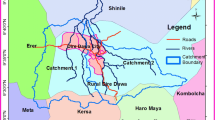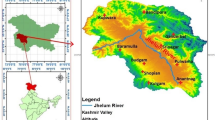Abstract
The torrential rains in June 2013 combined with melting of snow caused voluminous floods in the rivers of Uttarakhand and subsequently triggered widespread mud, landslides and debris deposition. The event caused instability of the channel by shifting the banks. Erosion rendered many locations along the banks vulnerable to economic and human loss. The shifts in reaches are calculated by digitizing the bank line using satellite imageries of year 2005, 2010 and 2015. The extent and magnitude of risks have been assessed based on information of past events, rapid field assessments, current mitigation measures and interactions with the locals. The findings from these interactions, and secondary data based on geospatial analysis of bank line changes have been used in the identification of vulnerable reaches along the major rivers. Criteria to identify the vulnerable reaches are based on risk, exposure and hazards in that area. The magnitude of risks due to flood hazards on various exposures along the riverbank is calculated based on qualitatively derived scores. River basins focusing on rainfall, topography, drainage pattern, soil, landslide and exiting infrastructure in relation to vulnerability of the region using GIS data are discussed in details. A fuller understanding will enable decision makers towards more efficient resources management for prevention and protection of river banks due to flood events. In addition to this, an official online decision support system (www.urmis.dhi-india.com) with collaborating partners and organizations for relevant data, information and document has been created.










Similar content being viewed by others
References
AHEC/IITR Report (2011) Assessment of cumulative impact of hydropower project in Alaknanda and Bhagirathi Basin for MoEF, GOI, New Delhi
Ahmed B, Ilan Kelman (2018) Measuring community vulnerability to environmental hazards: a method for combining quantitative and qualitative data. Nat Hazards Rev 19(3):04018008. https://doi.org/10.1061/(asce)nh.1527-6996.0000290
Allen SK, Rastner P, Arora M, Huggel C, Stoffel M (2016) Lake outburst and debris flow disaster at Kedarnath, June 2013: hydrometeorological triggering and topographic predisposition. Landslides 13(6):1479–1491
Auden JB (1934) The geology of the Krol belt. Bee. Geol Surv India 67(4):357–454
Bajracharya SR, Mool P (2009) Glaciers, glacial lakes and glacial lake outburst floods in the Mount Everest region, Nepal. Ann Glaciol 50(53):81–86
Bhambri R, Mehta M, Dobhal DP, Gupta AK, Pratap B, Kesarwani K, Verma A (2016) Devastation in the Kedarnath (Mandakini) Valley, Garhwal Himalaya, during 16–17 June 2013: a remote sensing and ground-based assessment. Nat Hazards 80(3):1801–1822. https://doi.org/10.1007/S11069-015-2033-y
Bharti V (2015) Investigation of extreme rainfall events over the Northwest Himalaya region using satellite data, Enschede, The Netherlands, Thesis pp 1–60
Bhatt GD, Sinha K, Deka PK, Kumar A (2014) Flood hazard and risk assessment in Chamoli District, Uttarakhand using satellite remote sensing and GIS techniques. Int J Innov Res Sci Eng Technol 3(8):15348–15356. https://doi.org/10.15680/ijirset.2014.0308039
Bollin C, Hidajat R (2006) Community-based disaster risk index: pilot implementation in Indonesia. In: Birkmann J (ed) Measuring vulnerability to natural hazards—towards disaster resilient societies. UNU-Press, Tokyo
Celerier J, Harrison TM, Beyssac O, Herman F, Dunlap JW, Webb AA (2009) The Kumaun and Garwhal Lesser Himalaya, India: Part 2. Thermal and deformation histories. Geol Soc Am Bull 121(9-10):1281–1297 ISSN 0016-7606
Cho C, Li R, Wang S-Y, Yoon JH, Gillies RR (2016) Anthropogenic footprint of climate change in the June 2013 Northern India flood. Clim Dyn 46(3):797–805. https://doi.org/10.1007/s00382-015-2613-2
Clague JJ, Evans SG (2000) A review of catastrophic drainage of moraine-dammed lakes in British Columbia. Quat Sci Rev 19:1763–1783
Damodar P, Parineeta D (2013) Uttarakhand rainfall: since 1901 and in light of the 2013 disaster. SANDRP, Climate Change, Uttarakhand. September 25, 2013
Dhingra D, Chakrapani GJ (2004) Estimation of silicate weathering in Upper Ganga river in Himalayas, India. Himal Geol 25(2):139–144
Dobhal DP, Mehta M, Srivastava D (2013a) Influence of debris cover on terminus retreat and mass changes of Chorabari Glacier, Garhwal region, central Himalaya, India. J Glaciol 59(217):961–971
Dobhal DP, Gupta AK, Mehta M, Khandelwal DD (2013b) Kedarnath disaster: facts and plausible causes. Curr Sci 105(2):171–174
Dube A, Ashrit R, Ashish A, Sharma K, Iyengar GR, Rajagopal EN, Basu S (2013) Forecasting the heavy rainfall during Himalayan flooding—June 2013. Weather Clim Extremes. 4(2014):22–34. https://doi.org/10.1016/j.wace.2014.03.004
Fujita K, Sakai A, Takenaka S, Nuimura T, Surazakov AB, Sawagaki T, Yamanokuchi T (2013) Potential flood volume of Himalayan glacial lakes. Nat Hazards Earth Syst Sci 13:1827–1839. https://doi.org/10.5194/nhess-13-1827-2013
Gansser A (1964) Geology of the himalayas. Wiley Inter-Science, New York, p 289
Greiving S, Fleischhauer M, Lückenkötter J (2006) A methodology for an integrated risk assessment of spatially relevant hazards. J Environ Plann Manag 49(1):1–19
Guha-Sapir D, Below R, Hoyois P (2014). EM-DAT: international disaster database. Université Catholique de Louvain, Brussels, Belgium. www.emdat.be. Accessed 06 June 2018
ICIMOD (2011) Glacial lakes and glacial lake outburst floods in Nepal. International Centre for Integrated Mountain Development (ICIMOD), Kathmandu
Immerzeel WW, Beek LPH, Bierkens MFP (2010) Climate change will affect the Asian water towers. Science. https://doi.org/10.1126/science.1183188
Jain SK (2008) Impact of retreat of Gangotri glacier on the flow of Ganga River. Curr Sci 95(8):25
Krishnaswamy VS, Shanker Ravi (1982) Scope of development, exploration and preliminary assessment of the geothermal resource potential of India. Rec Geol Surv India 111(2):17–40
Martha TR, Roy P, Govindharaj KB, Kumar KV, Diwakar PG, Dadhwal VK (2014) Landslides triggered by the June 2013 extreme rainfall event in parts of Uttarakhand state, India. Landslides 12(1):135–146. https://doi.org/10.1007/s10346-014-0540-7
Nadim F, Kjekstad O, Peduzzi P, Herold C, Jaedicke C (2006) Global landslide and avalanche hotspots. Landslides 3:159–173
O’Connor JE, Hardison JH, Costa JE (2001) Debris flows from failures of Neoglacial-age moraine dams in the Three Sisters and Mount Jefferson wilderness areas, Oregon. US Geological Survey Professional Paper 1606
Petley D (2012) Global patterns of loss of life from landslides. Geology 40(10):927–930. https://doi.org/10.1130/G33217.1
Pranab KD (2013) The Himalayan Tsunami—Cloudburst, flash flood & death toll: a geographical postmortem. IOSR J Environ Sci Toxicol Food Technol 7(2):33-45. e-ISSN: 2319-2402, p- ISSN: 2319-2399
Rao Durga KHV, Rao Venkateshwar V, Dadhwal VK, Diwakar PG (2014) Kedarnath flash floods: a hydrological and hydraulic simulation study. Curr Sci 106(4):598–603
Ravi S, Sorabh G, Swapneel K, Lalit K (2017) Geotechnical investigation across a failed hill slope in Uttarakhand—a case study. In: Indian geotechnical conference 2017 GeoNEst 14-16 December 2017, IIT Guwahati, India
Sati SP, Gahalaut VK (2013) The fury of the floods in the north-west Himalayan region: the Kedarnath tragedy. Geomat Nat Hazards Risk 4:193–201
Thakkar H, Dandekar P (2013) Uttarakhand Deluge: How human actions and neglect converted a natural phenomenon into a massive disaster. Cumulative Impact Assessment · Ministry Of Environment And Forests. SANDRP Jun 21 2013
Thakkar H, Dandekar P, Damodar P, Parag JS, Ganesh G (2013) Dams, rivers and people; working for water resources development as if democracy, people and environment matter, 11(5–6), June–July 2013
Van Westen CJ Quan Luna B Vargas Franco RD (2010) Development of training materials on the use of geo-information for multi-hazard risk assessment in a mountainous environment. In: Malet J-P, Glade T, Casagli N (eds) Mountain risks: bringing science to society: proceedings of the mountain risks international conference, Firenze, Italy, 24–26 November 2010. Strasbourg: CERG, 2010. ISBN 2-95183317-1-5, pp 469–475
Verma RK, Hamza VM, Panda PK (1970) Further study of the correlation of heat flow with age of basement rocks. Tectonophysics 10:301
Vilimek V, Emmer A, Huggel C, Schaub Y, Würmli S (2013) Database of glacial lake outburst floods (GLOFs) IPL project No. 179. Landslides 11:161–165. https://doi.org/10.1007/s10346-013-0448-7
Vishwanath VH and Tomaszewski B (2018) Flood hazard, vulnerability and risk assessments for Uttarakhand State in India. In: Geospatial technologies and geographic information science for crisis management (GIS) proceedings of the 15th ISCRAM Conference—Rochester, NY, USA May 2018
Vohra YK, Olijnik H, Grosshans W, Holzapfel WB (1981) Structural phase transitions in yttrium under pressure. Phys Rev Lett 47(15):1065
Worni R, Huggel C, Stoffel M (2013) Glacier lakes in the Indian Himalayas from an area-wide glacial lake inventory to on-site and modeling based risk assessment of critical glacial lakes. Sci Total Environ 468–469:s71–s84
Acknowledgement
This work has been carried out as preliminary part of the project funded by World Bank for “River Morphological Analysis and design for River Training and Bank Protection Works in Uttarakhand state for Project Implementation Unit TA and CBDRM”, Uttarakhand Disaster Recovery Project (URDP). With the grace and guidance of the spirit, we express gratitude to the Government of Uttarakhand, World Bank, UDRP, CWC, IMD and HEPs. We are deeply grateful various experts from IIRS Dehradun and IIT Roorkee for their insights during the project. Last but not least, our thanks go to WRD team members especially, Gorm Jeppesen (HoD,WRD), Lalit Monhan, Apuraban, Nilav and Amit (HoD, IT) for sharing their wisdom during the course of this work.
Funding
Funding was provided by DHI India.
Author information
Authors and Affiliations
Corresponding author
Additional information
Publisher's Note
Springer Nature remains neutral with regard to jurisdictional claims in published maps and institutional affiliations.
Rights and permissions
About this article
Cite this article
Ghosh, T.K., Jakobsen, F., Joshi, M. et al. Extreme rainfall and vulnerability assessment: case study of Uttarakhand rivers. Nat Hazards 99, 665–687 (2019). https://doi.org/10.1007/s11069-019-03765-3
Received:
Accepted:
Published:
Issue Date:
DOI: https://doi.org/10.1007/s11069-019-03765-3




